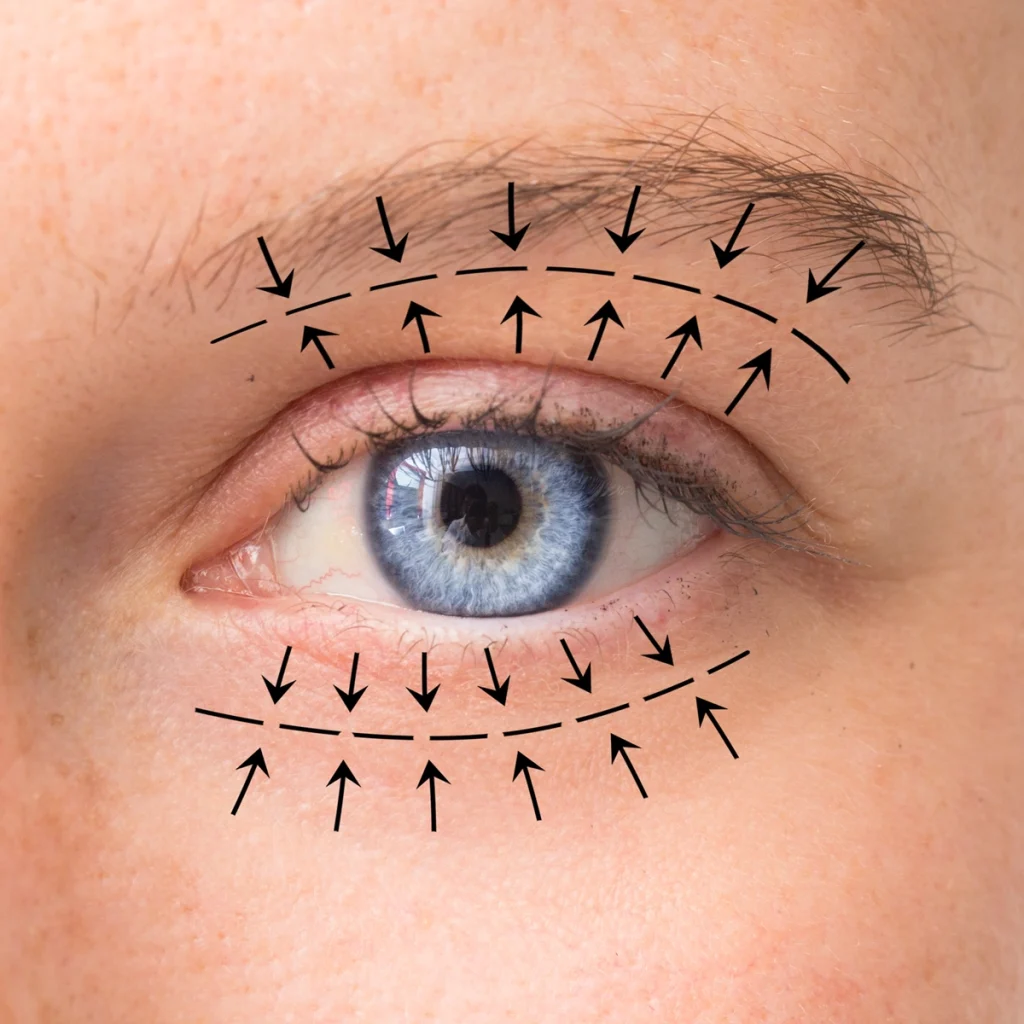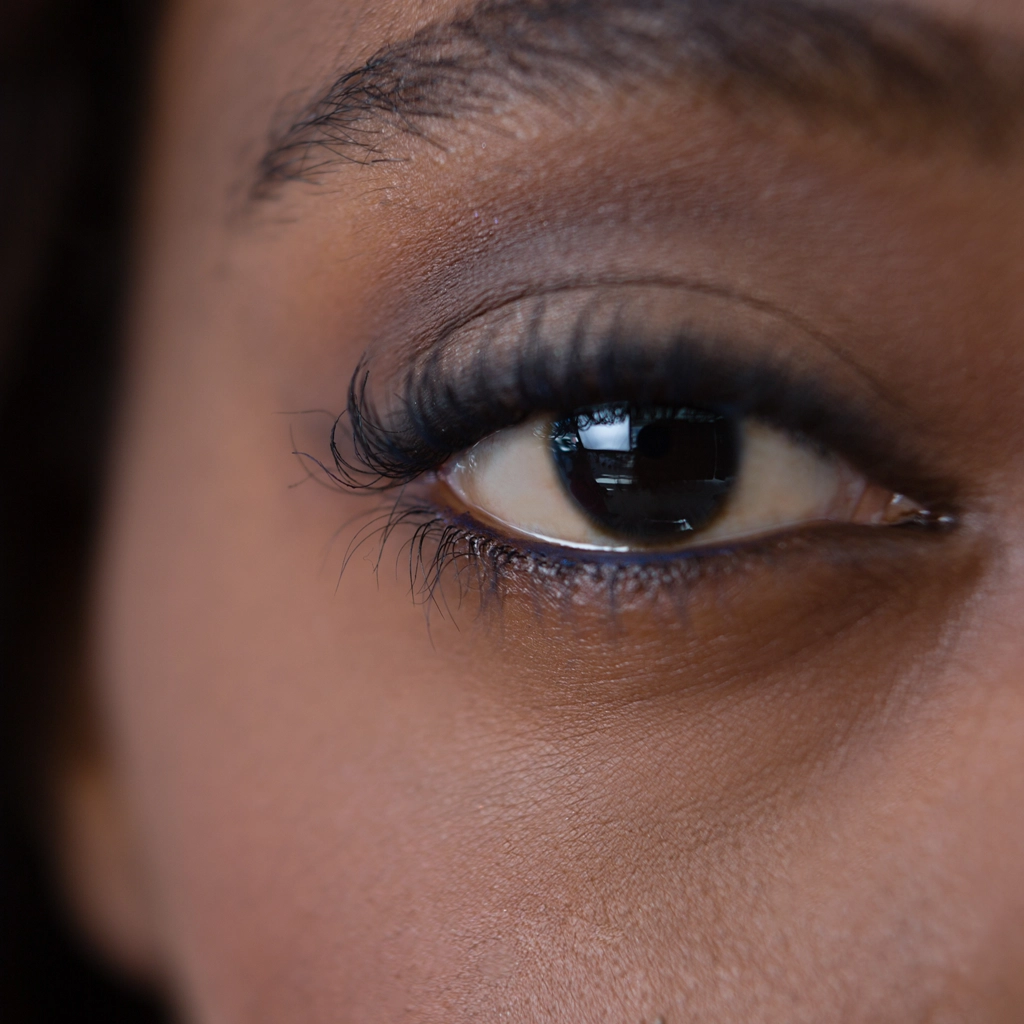Blepharoplasty, commonly known as eyelid surgery, is a cosmetic procedure aimed at rejuvenating the appearance of the eyelids by addressing excess skin, fat, and occasionally, muscle laxity. There are several two main types of blepharoplasty—upper and lower blepharoplasty.
Upper blepharoplasty focuses on improving the appearance of the upper eyelids. During the procedure, Dr. Desrosiers makes incisions along the natural creases of the upper eyelids to access and remove excess skin (and fat tissue if necessary). If the muscle needs to be tightened, this is done first and then the skin incision is closed with one long suture. Upper blepharoplasty can address concerns such as hooded or drooping upper eyelids, which may result from aging, genetics, or other factors. By removing redundant tissue and tightening the upper eyelid skin, upper blepharoplasty can create a more refreshed and youthful eyelid contour. Upper blepharoplasty surgery is often performed in the office under local anesthesia and light oral sedation.
Lower blepharoplasty targets the lower eyelids to address puffiness, under-eye bags, and loose or wrinkled skin. The surgical approach for lower blepharoplasty may involve making incisions either below the lower lash line (transcutaneous approach) or inside the lower eyelid (transconjunctival approach). Through these incisions, the surgeon can remove or reposition excess fat, tighten lax muscles, and trim excess skin to achieve a smoother and more youthful lower eyelid appearance. Lower blepharoplasty can help diminish the appearance of tired or aged-looking eyes, restoring a more rested and vibrant look to the face. Lower blepharoplasty surgery is typically performed under general anesthesia.
Quad blepharoplasty, also known as four-eyelid blepharoplasty, combines upper and lower eyelid surgery to comprehensively rejuvenate the entire eye area. The quad blepharoplasty procedure is typically performed under general anesthesia.
Upper and lower blepharoplasty are each a permanent procedure; however, the natural aging continues. With proper skincare and attention, the results of a blepharoplasty may last 10 years or more.
Individuals experiencing a range of cosmetic and functional concerns related to the eyelids may benefit from blepharoplasty. Particularly, upper blepharoplasty can be beneficial for those with excess skin causing drooping/heavy eyelids, puffiness, or hooded eyes, which can contribute to a tired appearance or obstruct vision. Lower blepharoplasty targets under-eye bags or puffiness caused by protruding fat deposits, smoothing out fine lines and wrinkles to rejuvenate the overall eye area.
Blepharoplasty can benefit individuals of various ages, as it addresses both genetic predispositions and age-related changes in eyelid appearance. While commonly sought for signs of aging like excess skin and under-eye bags, younger patients may also undergo the procedure to correct inherited traits or early-onset concerns.
Following a blepharoplasty procedure, patients typically have sutures in place for 3-5 days and may experience swelling or bruising. While office-based work can often be resumed a few days after the procedure, it’s important to note that some degree of swelling and discomfort may still be present. Each person’s preferred timing for returning to work after a blepharoplasty procedure can vary based on individual comfort levels, particularly concerning the presence of sutures.
In terms of usual activities such as exercise and wearing makeup, many patients can resume these around two weeks after the procedure. However, for several months, it’s essential to avoid activities that are likely to cause impact or strain on the scar site during the initial stages of recovery. This could potentially disrupt the healing process or cause discomfort.

Upper blepharoplasty typically involves placing the incision within the natural crease of the upper eyelid, allowing scars to be discreetly hidden and fade significantly over time with proper care.
Lower blepharoplasty may entail incisions made on the inner aspect of the eyelid (transconjuctival), helping ensure scarless results. However, in cases requiring a small skin excision, incisions are positioned either just below the lash margin or within the natural lower eyelid crease; the lower lid area typically heals very well and results in minimal, barely noticeable scarring.
To help ensure the best scar outcome, Dr. Desrosiers employs a meticulous approach. First, understanding each patient’s unique response to sutures is important. During the consultation, Dr. Desrosiers and his staff will seek to understand your medical history, including any prior procedures and experiences with stitch abscesses or rejection, to tailor the surgical approach accordingly. Second, Dr. Desrosiers uses preoperative photos and markings and refers back to the photos intraop and then uses a tailor tacking approach to deliver precision and beauty. Third, Dr. Desrosiers may utilize slowly dissolving sutures beneath the skin to prevent scar widening until wound remodeling has transformed weak Type 3 collagen into more robust type 1 collagen. Lastly, our practice offers cutting-edge treatments such as advanced silicone scar gels and laser scar therapies, which have shown remarkable efficacy in promoting seamless scar formation for many patients.

Dr. Desrosiers understands that each patient is unique and requires individualized care. With his expertise and dedication to achieving exceptional results, Dr. Desrosiers is committed to guiding you through your blepharoplasty journey with confidence and support.
To learn more about blepharoplasty or to schedule a consultation with Dr. Desrosiers, please contact us at 305-403-2922 or concierge@ArthurMD.com. Let Dr. Desrosiers help you achieve the body of your dreams with advanced blepharoplasty techniques and personalized care.

Providing Cosmetic, Reconstructive, & Craniofacial Plastic Surgery in Miami and West Palm Beach.